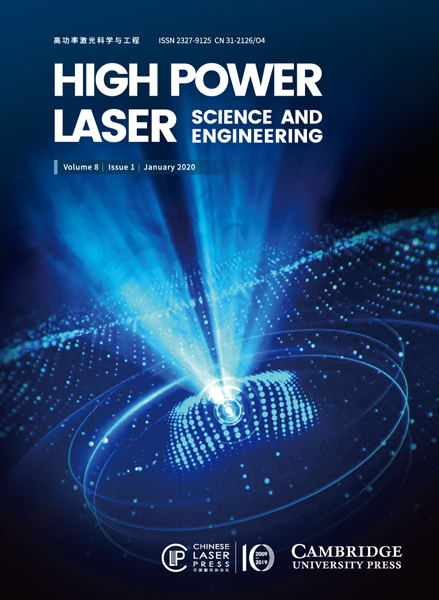2013, 1(1) Column
High Power Laser Science and Engineering 第1卷 第1期
Beam positioning stability in a laser-driven inertial confinement fusion (ICF) facility is a vital problem that needs to be fixed. Each laser beam in the facility is transmitted in lots of optics for hundreds of meters, and then targeted in a micro-sized pellet to realize controllable fusion. Any turbulence in the environment in such long-distance propagation would affect the displacement of optics and further result in beam focusing and positioning errors. This study concluded that the errors on each of the optics contributed to the target, and it presents an efficient method of enhancing the beam stability by eliminating errors on error-sensitive optics. Optimizations of the optical system and mechanical supporting structures are also presented.
beam stability beam stability beam propagation beam propagation sensitivity sensitivity laser optics laser optics vibration vibration We will review some of the requirements for a laser that would be used with a laser fusion energy power plant, including frequency, spatial beam smoothing, bandwidth, temporal pulse shaping, efficiency, repetition rate, and reliability. The lowest risk and optimum approach uses a krypton fluoride gas laser. A diode-pumped solid-state laser is a possible contender.
laser fusion energy The driving mechanism of solar flares and coronal mass ejections is a topic of ongoing debate, apart from the consensus that magnetic reconnection plays a key role during the impulsive process. While present solar research mostly depends on observations and theoretical models, laboratory experiments based on high-energy density facilities provide the third method for quantitatively comparing astrophysical observations and models with data achieved in experimental settings. In this article, we show laboratory modeling of solar flares and coronal mass ejections by constructing the magnetic reconnection system with two mutually approaching laser-produced plasmas circumfused of self-generated megagauss magnetic fields. Due to the Euler similarity between the laboratory and solar plasma systems, the present experiments demonstrate the morphological reproduction of flares and coronal mass ejections in solar observations in a scaled sense, and confirm the theory and model predictions about the current-sheet-born anomalous plasmoid as the initial stage of coronal mass ejections, and the behavior of moving-away plasmoid stretching the primary reconnected field lines into a secondary current sheet conjoined with two bright ridges identified as solar flares.
laboratory astrophysics magnetic reconnection laser plasma solar flare coronal mass ejection We review the use of hollow-core photonic crystal fibre (HC-PCF) for high power laser beam delivery. A comparison of bandgap HC-PCF with Kagome-lattice HC-PCF on the geometry, guidance mechanism, and optical properties shows that the Kagome-type HC-PCF is an ideal host for high power laser beam transportation because of its large core size, low attenuation, broadband transmission, single-mode guidance, low dispersion and the ultra-low optical overlap between the core-guided modes and the silica core-surround. The power handling capability of Kagome-type HC-PCF is further experimentally demonstrated by millijoule nanosecond laser spark ignition and 100 J sub-picosecond laser pulse transportation and compression.
High power beam delivery hollow-core photonic crystal fibre Kagome-type hollow-core photonic crystal fibre Cor Gas-phase Photonic Material Laser resistance and stress-free mirrors, windows, polarizers, and beam splitters up to 400 mm×400 mm are required for the construction of the series SG facilities. In order to improve the coating quality, a program has been in place for the last ten years. For the small-aperture pick-off mirror, the laser-induced damage threshold (LIDT) is above 60 J/cm2 (1064 nm, 3 ns), and the reflected wavefront is less than λ/4 (λ=633 nm). The Brewster-angle polarizing beam splitter (Φ50×10 mm) shows the best LIDT result, up to 29.8 J/cm2 (1064 nm, 10 ns) for a p-polarized wave in the 2012 damage competition of the XLIV Annual Boulder Damage Symposium. For the larger-aperture mirror and polarizer, the LIDT is above 23 J/cm2 (1064 nm, 3 ns) and 14 J/cm2 (1064 nm, 3 ns), respectively. The reflected wavefront is less than λ=3 (λ=633 nm) at the used angle.
laser coating laser-induced damage threshold wavefront An accelerated micro-foil is used to ignite a pre-compressed cylindrical shell containing deuterium–tritium fuel. The well-known shock wave ignition criterion and a novel criterion based on heat wave ignition are developed in this work. It is shown that for heat ignition very high impact velocities are required. It is suggested that a multi-petawatt laser can accelerate a micro-foil to relativistic velocities in a very short time duration (~picosecond) of the laser pulse. The cylindrical geometry suggested here for the fast ignition approach has the advantage of geometrically separating the nanosecond lasers that compress the target from the picosecond laser that accelerates the foil. The present model suggests that nuclear fusion by micro-foil impact ignition could be attained with currently existing technology.
Laser Plasma Fast ignition Heat wave Shock wave The chemical oxygen–iodine laser (COIL) is the shortest-wavelength high-power chemical laser that has been demonstrated. The characteristics, such as good atmospheric propagation, short wavelength and excellent transmission through optical fibers, make the COIL a good candidate for high-power laser application. To model the complete COIL lasing interaction, a three-dimensional formulation of the fluid dynamics, species continuity and radiation transport equations is necessary. The computational effort to calculate the flow field over the entire nozzle bank with a grid fine enough to resolve the injection holes is so large as to preclude doing the calculation. The approach to modeling chemical lasers then has been to reduce the complexity of the model to correspond to the available computational capability, adding details as computing power increased. The modeling of lasing in the COIL medium is proposed, which is coupling with the effects induced by transverse injection of secondary gases, non-equilibrium chemical reactions, nozzle tail flow and boundary layer. The coupled steady solutions of the fluid dynamics and optics in a COIL complex three-dimensional cavity flow field are obtained following the proposal. The modeling results show that these effects have some influence on the lasing properties. A feasible methodology and a theoretical tool are offered to predict the beam quality for large-scale COIL devices.
beam quality chemical oxygen–iodine laser (COIL) numerical simulation We present a 940 nm quasi-continuous wave semiconductor laser designed as a building block for high-power fiber coupled pump modules. The laser comprises a 400 μm narrow-stripe array mounted on an aluminum nitride substrate using hard solder. The chip has been optimized for high optical power and low lateral far-field angles. Two vertical and six lateral structure variations have been investigated to determine the best achievable performance. Operating at 1 ms pulse width and a repetition rate of 10 Hz, the laser device reaches a maximum pulse power of 86 W from a 400 μm aperture and more than 62% maximum conversion efficiency. Low lateral far-field angles (95% power enclosed) of 11.5 and 13.5°, depending on the epitaxial design, enable efficient multimode fiber coupling. The potential for highly reliable applications has been demonstrated.
diode laser high-power laser array optical fiber coupling 动态信息
动态信息 丨 2023-06-21
HPL Highlight (Vol. 11, e40): NIF仍然是全球唯一一个能够进行ICF点火实验的装置动态信息 丨 2023-06-21
HPL Highlight (Vol. 11, e9): 变分神经网络预测激光尾波场加速电子能谱动态信息 丨 2023-06-21
HPL Highlight (Vol. 11, e7): 目标探测网络加入,激光等离子体加速器实现实时诊断动态信息 丨 2023-06-21
HPL Highlight (Vol. 11, e5): 910 nm波段超宽带种子源,向100 PW超强超短激光进发动态信息 丨 2023-06-21
HPL Highlight (Vol. 11, e4): 100 PW单束压缩!多步压缩器进阶双光栅激光评论微信公众号

点击菜单“联系编辑”即可添加期刊编辑为好友啦












